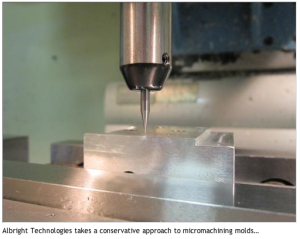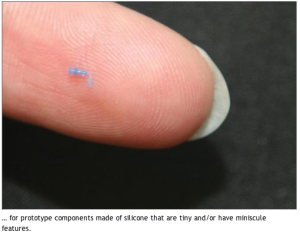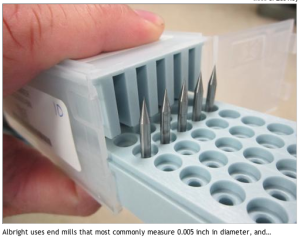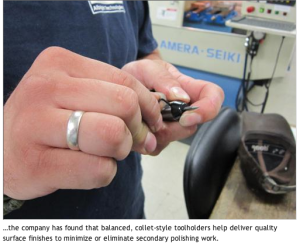|
Here's a story from the east coast that was in Modern Machine Shop not to long ago that we didn't want you to miss… A molder of tiny, silicone components for the medical industry explains how a patient, conservative approach to micromachining enables it to deliver prototypes faster. Article From: 10/12/2011 Modern Machine Shop, Derek Korn, Senior Editor
The pin in the center of this mold component is just 0.01 inch in diameter. In most cases, the single-cavity compression molds (typically machined from aluminum) are used to produce 10 to 100 silicone parts. Although the compression molding process is a manual one that uses hand-loads, it’s still quicker than creating tooling with mechanical or hydraulic actions for injection molding machines. Some molding is performed in Albright’s Class 7 clean room. In addition to providing a detailed white paper on its website about the features and benefits of silicone for medical applications, Albright provides free molded samples, such as the ones above, to show various surface finishes. The samples include machined, bead-blasted and polished surfaces for silicone components. Albright Technologies has become adept at micromachining molds for silicone parts such as the one to the right. This has enabled the company to become effective in quickly generating prototypes for medical device manufacturers pressured to speed new products to market. Many of the silicone components it creates are either tiny themselves or have miniscule features measuring just a few thousands of an inch. What’s interesting is that the company has found it can produce prototypes faster by taking a slower, more conservative approach to micromachining molds using end mills that measure just a few thousands of an inch in diameter. Plus, while one might assume that very high spindle speeds are needed to effectively mill molds using such small tools, the machine that performs micromachining at Albright—a 30-taper VMC—typically spins 0.005-inch-diameter tools at just 9,000 rpm. Although that means feed rates and cycle times are relatively slow, there are a number of reasons why a company focused on quickly turning prototyping work finds this acceptable. David Comeau, Albright’s president, and Robert Waitt, vice president, explained why during a recent visit to the New England-area molder.
Early on, Mr. Comeau noticed that medical device manufacturers needed responsive vendors that could quickly generate small batches of little silicone components for product prototypes. In its first attempt at this type of work, Albright was able to create tooling and present a limited number of prototypes to its customer in just three weeks. This was half the time that the customer’s other vendor could deliver such small parts. Ultimately, Albright created prototypes for 60 iterations of that product, and Mr. Waitt estimates the company saved its customer 1.5 years in development time because of fast prototype turnaround. After that, the customer presented Albright with other similar projects, which ultimately spurred the company to shift its strategy to focus on low-volume, silicone parts production for medical device manufacturers. Today, typical turnaround from receipt of a CAD file to the delivery of parts is only five days.
Here are some of the key elements of Albright’s micromachining process:
The 30-taper Cyclone VMC from Amera Seiki that Albright uses for micromachining was selected for a few reasons, including its price, size, thermal stability and PC-based control. Its small size occupies minimal floor space, and its moving components have less mass to facilitate quicker movements. A cooling jacket around the machine’s spindle helps maintain machining stability, because just a small amount of thermal growth becomes a big issue during micromachining. This is also why the company accurately controls temperature and humidity on its shop floor. The VMC’s PC-based control eases adjustments to parameters such as acceleration and deceleration. The control’s open-architecture platform also simplified replacement of the machine’s original rotary encoders with glass scales. These half-micron-resolution scales deliver precise positioning feedback, which is vital when making micromachining movements. Plus, shop personnel can remotely log in to monitor unattended machine performance.
Given its experience, Albright will replace the tools, based on knowledge of approximate life, before wear becomes an issue. Even though each tool costs approximately $70, the company would rather not risk losing a day’s worth of machining due to unexpected breakage or premature wear just to maximize total cutting time for a tool.
Albright uses balanced toolholders from Techniks, but these are not hydraulic or shrink-fit models. Instead, the company has found that collet-style toolholders that use a setscrew to secure tools work well for its micromachining operations. These toolholders help to provide accurate concentricity, which is important to prevent a micro-tool from taking a deeper-than-anticipated cut and possibly breaking. Plus, while the company experimented with the aforementioned types of toolholders, it didn’t notice any improvement in surface finish versus the collet-style toolholders. Achieving a quality surface finish is important to minimize or eliminate polishing, which can adversely affect dimensional accuracy as well as extend mold manufacturing time.
Consider touching-off micro-tools. Mike Collette, senior tool and die maker, sets up many micromachining jobs. Although he had no prior experience with such small cutters, he’s become adept at manually touching-off tools with tips that he can barely see without magnifying lenses. Of course, it took time to master this art, and he did break some of the costly micro-tools. However, unlike his previous jobs in which there might be hell to pay for mishaps such as that, Mr. Comeau was understanding and accepting. He tolerated some breakage during initial setups because he recognizes how challenging the job is. Without the pressure to be perfect right out of the gate, Mr. Collette was able to establish an effective approach for touching-off tools. Now, breakage during setup isn’t an issue. Mr. Collette has found ways to do it quicker, too. He used to position a tool 0.050 inch or so away from a workpiece before moving in 0.0001-inch increments to bring the tool in contact with the part. This would take almost 20 minutes. These days, he starts closer to 0.004 inch away from the workpiece, meaning fewer increments are required prior to contact. In fact, he’s reached the point in which he can tell whether a delicate end mill touched a workpiece on a “hard” tenth or a “light” tenth. Touching the workpiece with a light tenth means the tool hit the top of a ridge left behind by a previous tool, while the tool hits the true depth with a hard tenth. Trending Smaller Albright is in a good position to succeed, because medical devices continue to get smaller, and silicone is becoming more widely accepted for medical applications. The key for the company is becoming involved with a customer early in the new-product design cycle. Albright focuses on not only providing design for manufacturability input, but also educating its customers about the key properties and benefits of silicone. Albright offers a wealth of information on its company website, but it also offers silicone.pro and matsilicone.com. At silicone.pro, the company blogs about the latest silicone technologies, answers customer questions and encourages other silicone professionals to contribute with blog posts of their own. On the other hand, matsilicone.com is a growing silicone database in which users can search and compare properties of all health-grade silicone materials that are currently available. In addition, Albright provides sample strips demonstrating the types of finishes that are possible with machining molds for silicone. These and other sales tools help the company get its foot in the door with new customers, Mr. Waitt notes. While Albright continues to refine its micromachining processes, it is keeping its eye on additive manufacturing technologies. Mr. Comeau says some of these technologies currently can produce parts in materials that are somewhat similar to silicone, but none can work with actual silicone. This is likely to change as additive equipment manufacturers continue material R&D, he says, and it is leaving the door open to integrating such a process as a complement to its conventional micromachining and molding practices.
0 Comments
|
NEWSOur NEWS blog section is written by several different people. Sometimes, it from our team here at Next Generation Tooling & at other times it's by one of the manufacturer's we represent. Archives
July 2024
Categories
All
|
About
|
© 2024 Next Generation Tooling, LLC.
All Rights Reserved Created by Rapid Production Marketing
|







 RSS Feed
RSS Feed
